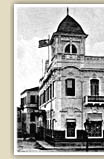
To the Military Government of the National Bank of Greece
Dear Governor,
The National Bank, making its appearance in Smyrna in the first months of the Greek occupation,
may justly be proud of the work achieved during its three-year presence there. Its colossal endeavours match the magnificent work of Greece; a practical work and useful both
to the Greek administration and the army and the people of Asia Minor; a work
that has caused the admiration of the Greeks abroad and the respect of foreign populations [...].
SERVICES OF THE BANK TO THE ARMY
The National Bank also provided many services to the Asia Minor Army.
When, during the first year of occupation, the Army pay department in Smyrna was under
the command of the Greek administration and, later, when this service was managed by the Army,
all the Army's cash needs were dealt with through the National Bank Branch.
The National Bank was always in charge of the conversion of drachmas in to Turkish liras or other
currency for the needs of the Army and systematically regulated these transactions, thus achieving the best price and preventing as far as possible the rapid devaluation of the drachma
due to its influx in large quantities in to Asia Minor, where, according to the Treaty of Sevres,
Turkish currency was in compulsory circulation.
The National Bank also helped to a large extent in provisioning the Army. Grain was
sent from Athens in the name of the National Bank, which saw to it that the grain loads were more economically
unloaded, securely stored and carefully delivered.
The National Bank also provided many services to the Headquarters of the Army.
The Directorate of railways of the Army drew essential information related to agreements, prices and even
technical works from the rich archive concerning surveys on the Railways of Asia Minor.'
Source: Veremis Th., and Kostis K., I Ethniki Trapeza sti Mikra Asia
(1919-1922), Athens, National Bank Cultural Foundation (MIET), 1984,
p. 244 and 248.
|
